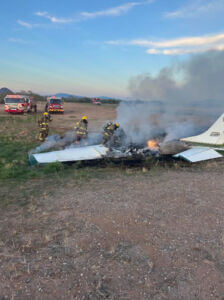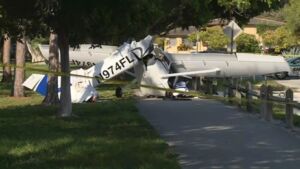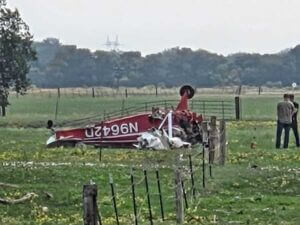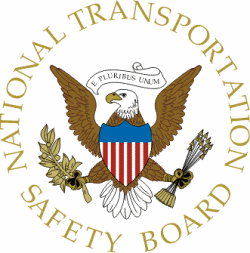These are the stories for today...
Be safe out there!
Tom
Emergency crews responded to an aircraft fire at Ryan Airfield
Marissa Orr
TUCSON, Ariz. (KVOA) - The Drexel Heights Fire District responded to a report of an airplane accident at Ryan Airfield over the weekend.
District responded to a report of an airplane accident at Ryan Airfield over the weekend.
Officials said in the evening of July 26, Drexel Heights crews were dispatched after reports of a small general aviation aircraft off the runway and on fire.
The Ryan Tower confirmed that all three occupants had evacuated the plane before emergency teams arrived, according to officials.
Upon arrival, firefighters found the aircraft fully engulfed in flames but quickly contained the fire. Paramedics evaluated the three individuals, who declined treatment and no injuries were reported, officials said.
The Tucson Airport Fire Department was also on the scene to assist crews.
The cause of the incident remains under investigation, according to officials.
https://www.kvoa.com/news/local/emergency-crews-responded-to-an-aircraft-fire-at-ryan-airfield/article_8d5f1685-b68c-4cbb-9a9a-ab7ab3d00f8d.html
7 injured after small plane crashes into car in Florida
The small single-engine aircraft crashed right after takeoff, officials said.
By Clara McMichael
A small plane clipped a tree before skimming the top of a car, then crashing in a park on Monday, resulting in seven people being transported to the hospital, according to Palm Beach County Fire Rescue.
top of a car, then crashing in a park on Monday, resulting in seven people being transported to the hospital, according to Palm Beach County Fire Rescue.
Two people were on board the Orlican M8 Eagle, a small single-engine aircraft, according to the Federal Aviation Administration.
Palm Beach County Fire Rescue said two people were Trauma Alert criteria and were transported to the Palm Beach County Trauma Center.
The five people in the car, one adult and four children, were transported to a local hospital for evaluation.
Palm Beach County Fire Rescue said there was no fire and no large fuel leak. The aircraft sustained "extreme damage" to the nose and the vehicle had minor damage to the roof.
The plane crashed in a neighborhood in Lake Worth, Florida, according to the FAA. The incident occurred around 4:45 p.m.
According to the flight track on FlightRadar24, the plane crashed right after takeoff.
The FAA and the National Transportation Safety Board will both investigate.
https://abcnews.go.com/US/7-injured-after-small-plane-crashes-car-florida/story?id=124153988
1 dead, 1 injured in plane crash near New Underwood
by: Eric Mayer, Marissa Brunkhorst
SIOUX FALLS, S.D. (KELO) – A plane crashed near New Underwood Monday morning and the National Transportation Safety Board is investigating the crash, the agency posted on social media.
New Underwood Monday morning and the National Transportation Safety Board is investigating the crash, the agency posted on social media.
According to a post on X, “NTSB is investigating the July 28 crash of a Piper PA-22-150 airplane near New Underwood, South Dakota.”
The Pennington County emergency manager confirmed one person died in the crash.
The New Underwood Fire Department responded to the crash around 6 a.m. near 159th Avenue, southwest of New Underwood. There was a passenger on the plane who was taken to a hospital with life-threatening injuries, according to a post on X from the fire department.
KELOLAND’s Tyler Louder is looking into the crash and will have more details online and on air Monday.
https://www.keloland.com/news/local-news/ntsb-investigating-plane-crash-near-new-underwood/
NTSB Final Report: Curtiss Wright P-40E
Witnesses Reported That They Heard A Loss Of Engine Power
Location: Hamilton, Montana Accident Number: WPR23FA244
Date & Time: June 27, 2023, 07:59 Local Registration: N4420K
Aircraft: Curtiss Wright P-40E Aircraft Damage: Substantial
Defining Event: Loss of engine power (partial) Injuries: 1 Fatal
Flight Conducted Under: Part 91: General aviation - Personal
Analysis: Witnesses reported that the airplane departed from runway 35 after a successful runup. During the initial climb, multiple witnesses reported that they heard a loss of engine power and saw the airplane make a left turn before it descended and impacted terrain.
Postaccident examination of the airplane and engine did not reveal any preimpact mechanical anomalies. Flight control continuity was established from the cockpit control to each flight control surface. The crankshaft was manually rotated by the reduction gear and mechanical continuity of the engine was established throughout the rotating group, valvetrain, and accessory section. Though mechanical continuity was established, the engine could not be placed on the test stand due to impact and thermal damage. Damage to the propeller blades indicated they were under low to no power at impact.
The pilot’s postmortem toxicological testing detected Citalopram, a prescription medication commonly used to treat depression and anxiety, However, according to a Federal Aviation Administration medical review, the pilot received multiple renewal letters, medication follow-up checklists, and reports of formal evaluations of his medical conditions within the pilot’s medical certification file, indicative of successful management of his condition from 2014 to
2023. Based on the pilot’s medical history, he was likely not impaired by his condition; witnesses reported that the pilot was in a good mood during the preflight.
The pilot was likely attempting to make a forced landing to a field about 1/2 mile from the departure airport. The airplane appeared to hit hard on the nose/engine in a nearly wings-level attitude and skidded about 216 ft. Based on the available information, the reason for an engine loss of power could not be determined.
Probable Cause and Findings: The National Transportation Safety Board determines the probable cause(s) of this accident to be -- A loss of engine power for undetermined reasons.
FMI: www.ntsb.gov

Today in History
27 Years ago today: On 29 July 1998 A Selva Taxi Aéreo Embraer EMB-110 Bandeirante crashed during a forced landing on the Manacapuru River, Brazil, killing 12 occupants; 15 survived the accident.
| Date: | Wednesday 29 July 1998 |
| Time: | 13:30 |
| Type: | Embraer EMB-110P1 Bandeirante |
| Owner/operator: | Selva Taxi Aéreo |
| Registration: | PT-LGN |
| MSN: | 110343 |
| Year of manufacture: | 1981 |
| Engine model: | P&W Canada PT6A-34 |
| Fatalities: | Fatalities: 12 / Occupants: 27 |
| Other fatalities: | 0 |
| Aircraft damage: | Destroyed, written off |
| Category: | Accident |
| Location: | 100 km W of Manaus, AM - Brazil |
| Phase: | En route |
| Nature: | Passenger - Scheduled |
| Departure airport: | Manaus-Eduardo Gomes International Airport, AM (MAO/SBEG) |
| Destination airport: | Tefé Airport, AM (TFF/SBTF) |
| Investigating agency: | CENIPA |
| Confidence Rating: | Accident investigation report completed and information captured |
Narrative:
A Selva Taxi Aéreo Embraer EMB-110 Bandeirante crashed during a forced landing on the Manacapuru River, Brazil, killing 12 occupants; 15 survived the accident.
The EMB-110 Bandeirante operated on a domestic flight from Manaus to Tefé, Brazil. Although the airplane was certificated for a maximum of 19 passengers, there were 25 passengers on board. Also, for financial reasons the crew decided to take more fuel than necessary for this flight. This resulted in the airplane departing with an excess of weight of 852 kg. About 20 minutes into the flight the oil pressure of the no. 2 engine dropped. The crew reduced engine power to 72% and continued to Tefé. When the flight was 185 km from Manaus at FL85 the oil pressure dropped to 40psi and the TGT increased. The copilot shut down the engine and the captain turned the airplane around, back to Manaus. At 13:15 the crew contacted Manaus ACC reporting that they were returning on one engine. The overloaded airplane flying on one engine, began to lose height. During the descent the speed was kept around 105 kts which occasionally caused activated stick shaker. To lose weight, the left overwing exit was opened and luggage of the passengers was jettisoned. The airplane did not make it to Manaus and an emergency landing on the Manacapuru River was made. The Bandeirante landed hard on the water, causing an opening in the fuselage. It sank quickly.
CONCLUSION (translated from Portuguese):
Human Factor - Psychological Aspect - Contributed
There was the participation of psychological variables, at the individual and organizational levels, which interfered in the performance and decisions of the crew.
Material Factor - Undetermined
It was not possible to examine the debris of the aircraft to determine the contribution of this factor to the failure of the left engine.
Operational Factor
(1) Deficient Maintenance - Undetermined
It is possible that the failure to carry out a type B2 inspection and/or to carry out a type A1 inspection by an unqualified person may have contributed to the occurrence of a low oil pressure emergency, due to material deterioration or inadequate services.
The impossibility of examining the aircraft could not determine this aspect.
(2) Deficient Supervision - Contributed
The owner of the air taxi company participated due to lack of adequate supervision in the planning of operations, at the technical, operational and administrative levels. This deficiency can be characterized, among other things, by the owner of the company that allowed the aircraft to fly with the type B2 inspection expired; by the excessive amount of fuel, when refueling in Manaus; by the unreasonable number of people on board, causing the aircraft to fly with excess weight, and still, by the receipt of pilots' salary to be conditioned to the accomplishment of the fateful flight.
(3) Deficient Cabin Coordination - Contributed
Errors were made by the aircraft crew due to the improper use of the resources available in the cabin, intended for the operation of the aircraft, due to non-compliance with operational rules.
(4) Deficient Planning - Contributed to
There was a mistake made by the crew due to the inadequate preparation for the flight, assuming numerous failures, such as: the nonconference, by the pilots, of the cargo and passengers manifest; the lack of the realization of a briefing and still, to accept an aircraft for a flight, being the same with its inspection not carried out.
(5) Deficient Judgment - Contributed
An error was made by the crew due to inadequate evaluation of certain aspects of the flight. Such deficiency was evidenced when the first sign of failure of the lubrication system occurred, after twenty minutes of flight, and even so, they decided to proceed with the flight, when the most sensible and safe would be the return, immediately, to Manaus.
(6) Disabled Support Staff - Contributed
The airline's support staff participated in the planning of weight and balance of the aircraft and the number of passengers on board, providing incorrect information to the aircraft's crew members. In addition, the mechanic who performed the A1 type inspection was not qualified for the function.
(7) Flight Discipline - Contributed
There has been intentional non-compliance by the crew members with the operational rules established by the aircraft manufacturer.
(8) Other Operational Aspects - Contributed
The Commander did not foresee what was predictable, for lack of caution, thus intentionally increasing the risk margin of the mission.
